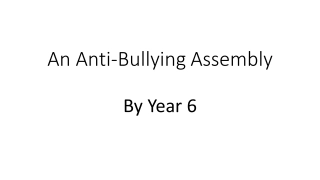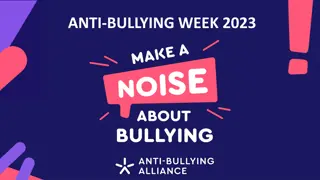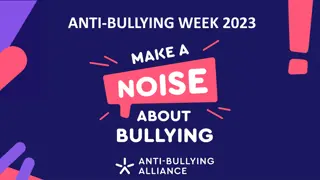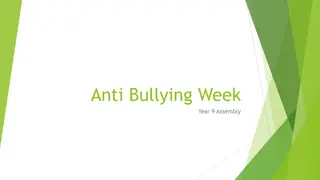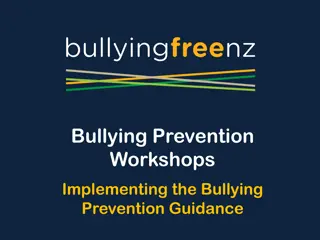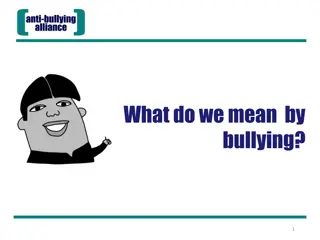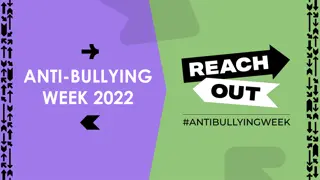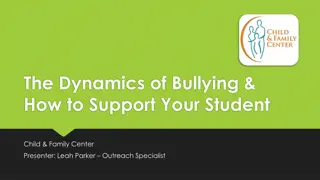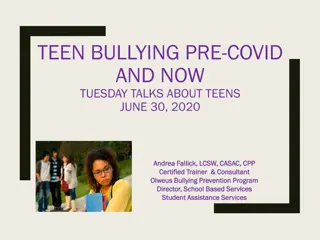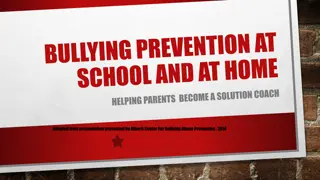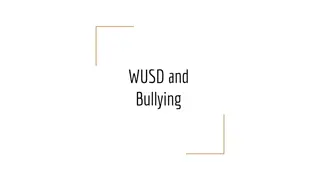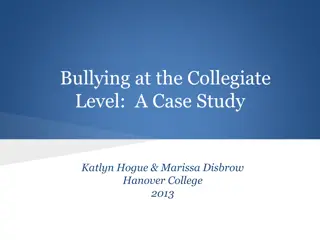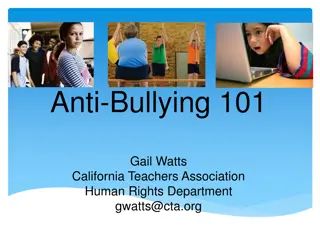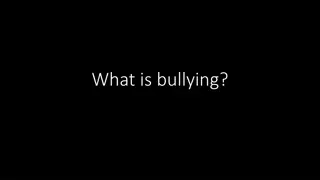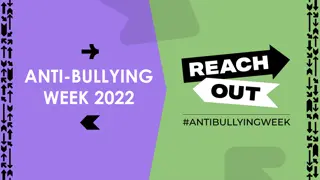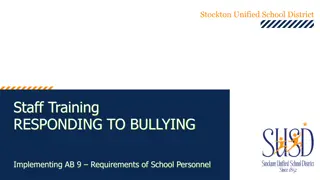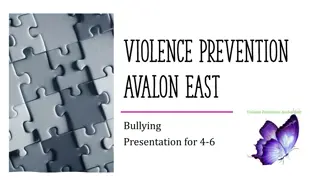Understanding Bullying Behaviors and Impact: Review and Reflection
Explore the concepts of respectful and disrespectful behaviors, bullying characteristics, who is more likely to be bullied, reasons behind bullying, and the lasting impact of bullying through a review and reflection session. Delve into Mr. Palm's story to understand the profound impact of bullying behaviors and how bystanders can intervene effectively in bullying situations.
Download Presentation

Please find below an Image/Link to download the presentation.
The content on the website is provided AS IS for your information and personal use only. It may not be sold, licensed, or shared on other websites without obtaining consent from the author. Download presentation by click this link. If you encounter any issues during the download, it is possible that the publisher has removed the file from their server.
E N D
Presentation Transcript
Review During the last homeroom we covered respectful behaviors disrespectful behaviors bullying To review this information and explore your knowledge of bullying behaviors, please answer the following questions with the help of your classmates.
Review 1. Being disrespectful to someone means that you are bullying them. a. True b. False
Review 2. Which of the following is a typical characteristic of bullying behavior? a.Intentional b.Repeated c. Harmful d.All of the above
Review 3. Who is more likely to be bullied? a. Girls b. Boys c. Boys and girls are equally likely to be bullied
Review 4. Teens are more likely to be bullied by: a.Someone they know (peers) b.Someone they don t know (strangers) c. Both strangers and peers at an equal rate
Review 5. Why do some teens bully others: a. To get revenge b. To become popular c. To feel better about themselves d. All of the above
To help you understand the lasting impact of bullying behaviors and the profound impact a bystander is able to have in a bullying situation, Mr. Palm, an art teacher here at Memorial, was willing to tell you his story. Please listen closely. Mr. Palm has chosen to share his story so that we can understand what he learned from his experience with bullying. Although we want to discuss bullying in general, this is not the time for sharing the stories of others, especially when we do not have their permission to do so. Mr. Palm Video/Bullying Click on the link
Reflection: What are some of the things that Mr. Palm said contributed to this case of bullying? How was Mr. Palm made aware of the impact of his bullying? What would be some other/better ways to intervene and stop bullying when you see it? What would you have done if you were one of the friends with Mr. Palm returning from lunch that day?
Be an Up-Stander-not a By-Stander If you or someone that you know is being bullied, it is time to Stand Up, Speak Up, and Step Up. Doing nothing actually is doing something: It is silently agreeing with the bullying. It is time to take a stand and make a difference. Here are some examples of ways to help/stand up to bullying.
BE THERE: The simplest thing that you can do when you see someone is being treated badly is to be a friend to him or her. The moment when somebody is being harassed, teased, threatened, or humiliated is probably the very moment when he/she feels the most alone. That person needs a reminder that others really do care. You can also encourage you friend to use one of these strategies:
Suggestions for what to do if you are bullied and how to help your friends/family: (review) Talk about it. Never keep it to yourself. You need a support system to get through this. Laugh it off Often the person is seeking attention. By making a joke of the incident, you could diffuse the situation and minimize the attention the bully is seeking. Ignore it. People who bully like the attention. Do not acknowledge what they said or wrote in any way. Speak up. Tell the person directly to stop or ask a friend to do this on your behalf. Unfriend the person on social media sites.
What do you do continued. Keep a journal. If it happens verbally write it down. If it happens on social media, take a screen shot and keep it. Document with as much detail as possible. Never retaliate: You need to show/provide evidence that the other person was bullying you. If you retaliate, it looks like you were both bullying. When you must tell an adult: When you feel scared, feel threatened, when you want to avoid school or being with certain people, events, or places, when you find that the situation is all you can think about, when the situation is negatively affecting your life, when you are depressed or if you feel suicidal, please tell an adult.
BUILD A GROUP EFFORT: After stepping up and being a friend to someone who is being bullied, take your efforts further. Consider getting some of your friends to come together and rally around the person being bullied. There is strength-and safety-in numbers. Even when you most want to do what is right, you ll probably be a little worried about becoming the next target of the bully. If your voice and support is echoed by others, you will feel stronger and more secure.
CRUSH CRUEL CONTENT: We have all seen a YouTube video that starts with a few viewers and then goes viral. In the same way, online rumors, gossip, and other hurtful content can go from person to person to person in just seconds. This chain reaction can be devastating, but you can stop it in its tracks by never forwarding or sharing cruel or inappropriate content. When you do face these situations-moments when you have to decide whether to participate, step up, or speak up, how will you respond? Please read the following scenarios and discuss what you would do:
RECORD IT AND REPORT IT: To protect yourself and those being bullied, keep track of who, what, and when bullying behavior occurs. Screen shots and written journals can establish a repeated pattern of behavior that adults and websites can use as evidence to stop the bullying behavior. Please share this information with a trusted adult.
TALK TO A TRUSTED ADULT: When you are concerned about a family member or friend who is being bullied, you need support and should confide in a trusted adult. A trusted adult is someone who will listen to you carefully when you explain the problem and will ask what you would like to see happen- someone who will make sure that your voice is heard and will work with you to come up with a plan that makes sense. This trusted adult will work behind the scenes to resolve the bullying problem without directly or publicly involving you. The adult will try to protect both you and the person being bullied. Possible trusted adults include: your parents or other adult family members, an adult at school-teacher, counselor or principal, a coach, faith leader, or a close family friend.
You and a few of your friends get a text message from Blake. The text includes pictures of your classmate Emma wearing a bikini. The message labels her a whale and Blake tells you to forward the photos to your friends. What would you do? Scenario 1:
Sam has been getting messages like you re such a loser and you suck from a couple of people at school. He deletes the messages, but they keep coming. He shares this information with you. What would you do? Scenario 2:
While surfing the internet one night, you stumble on a website someone has made about Micah, a student at your school. The site includes embarrassing photos and hurtful information. What would you do? Scenario 3:
In the library you notice Crystal, who is sitting next to you, writing down the username and password for the Facebook account of Jesse, who s sitting at a computer in the row ahead of you. What would you do? Scenario 4:
To help you understand the impact of bullying on your friends and neighbors, a parent of a former student was willing to tell you her story. Please listen closely. The individual depicted in this video has chosen to share her story so that we can understand what her family went through and how they handled the bullying. Although we want to discuss bullying in general, this is not the time for sharing the stories of others, especially when we do not have their permission to do so. Video: Parent story/Bullying Click on the link
Reflection: What is the impact of bullying on the student of question? What is the impact of bullying on the family of the student in question? In this situation, who else is affected? Identify 3 adults in the building who would help you in a bullying situation. Think of situation and/or situations that you or someone you know has been in, what have you done (silent reflection?)? In this video, there was a parent advocate, identify other adults beyond a parent who you can be your advocate. Do you feel like you can stand up and help others? Will it get worse before it gets better? Identify and/or brainstorm how to help others who are in need.


